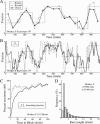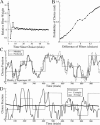Linear-Nonlinear-Poisson models of primate choice dynamics
- PMID: 16596981
- PMCID: PMC1389782
- DOI: 10.1901/jeab.2005.23-05
Linear-Nonlinear-Poisson models of primate choice dynamics
Abstract
The equilibrium phenomenon of matching behavior traditionally has been studied in stationary environments. Here we attempt to uncover the local mechanism of choice that gives rise to matching by studying behavior in a highly dynamic foraging environment. In our experiments, 2 rhesus monkeys (Macacca mulatta) foraged for juice rewards by making eye movements to one of two colored icons presented on a computer monitor, each rewarded on dynamic variable-interval schedules. Using a generalization of Wiener kernel analysis, we recover a compact mechanistic description of the impact of past reward on future choice in the form of a Linear-Nonlinear-Poisson model. We validate this model through rigorous predictive and generative testing. Compared to our earlier work with this same data set, this model proves to be a better description of choice behavior and is more tightly correlated with putative neural value signals. Refinements over previous models include hyperbolic (as opposed to exponential) temporal discounting of past rewards, and differential (as opposed to fractional) comparisons of option value. Through numerical simulation we find that within this class of strategies, the model parameters employed by animals are very close to those that maximize reward harvesting efficiency.
Figures













References
-
- Barraclough D.J, Conroy M.L, Lee D. Prefrontal cortex and decision making in a mixed-strategy game. Nature Neuroscience. 2004;7:404–410. - PubMed
MeSH terms
LinkOut - more resources
Full Text Sources
Miscellaneous

